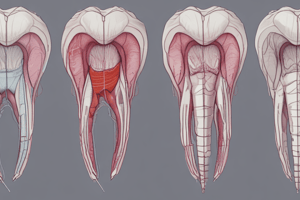Podcast
Questions and Answers
What role do neurotrophins play in tooth development according to recent findings?
What role do neurotrophins play in tooth development according to recent findings?
- They suggest a potential involvement of neural-like cells in odontogenesis. (correct)
- They are required for the formation of nerve fibres in teeth.
- They exclusively influence the development of second arch mesenchyme.
- They are essential for the vascularization of the dental papilla.
What happens when first arch epithelium is combined with first arch mesenchyme?
What happens when first arch epithelium is combined with first arch mesenchyme?
- Bone and cartilage develop instead of teeth.
- Tooth germs are formed. (correct)
- No development occurs.
- Only second arch epithelium is capable of forming tooth germs.
What is indicated by the lack of tooth germ development when second arch epithelium is combined with mesenchyme?
What is indicated by the lack of tooth germ development when second arch epithelium is combined with mesenchyme?
- The odontogenic potential is limited to specific combinations of epithelium and mesenchyme. (correct)
- First arch mesenchyme can initiate odontogenesis under any conditions.
- Second arch mesenchyme has a dominant influence on tooth development.
- Second arch epithelium has exclusive odontogenic potential.
At what stage does the first arch epithelium retain its potential to initiate tooth development?
At what stage does the first arch epithelium retain its potential to initiate tooth development?
What occurs when neurotrophins and their receptors are not expressed in transgenic animals?
What occurs when neurotrophins and their receptors are not expressed in transgenic animals?
At what stage of tooth development do nerve fibres first appear in relation to dental epithelium?
At what stage of tooth development do nerve fibres first appear in relation to dental epithelium?
Which type of nerve fibres is presumed to lie free within the dental papilla?
Which type of nerve fibres is presumed to lie free within the dental papilla?
What is the primary research focus regarding odontogenesis in recent studies?
What is the primary research focus regarding odontogenesis in recent studies?
What is presumed about nerve fibres associated with blood vessels during tooth development?
What is presumed about nerve fibres associated with blood vessels during tooth development?
When does the innervation of the dental papilla become fully developed?
When does the innervation of the dental papilla become fully developed?
Flashcards are hidden until you start studying
Study Notes
Tooth Development - Role of Nerve Cells and Neurotrophins
- Although nerve fibres are not required for odontogenesis, the pattern of neurotrophin localisation suggests a possible role for neural-like cells.
- Experiments with transgenic animals where neurotrophins and their receptors are not expressed, tooth development is not affected.
Tooth Development - Blood Supply
- Small blood vessels invade the dental papilla in the early bell stage.
- Blood vessels are also present in the dental follicle.
- There is conflicting evidence on nerve fibre presence and location during early tooth development.
- Nerves are present in the vicinity of presumptive dental epithelium and subsequently form a plexus below the dental papilla.
- Nerves spread into the dental follicle and penetrate the dental papilla with the onset of dentinogenesis.
- Nerve fibres associated with blood vessels are presumed to be autonomic, while those lying free within the papilla are likely sensory.
- Innervation of the dental papilla remains rudimentary until after birth, with full development possibly occurring after tooth eruption.
Experimental Manipulation of Tooth Germ
- The tooth germ can be easily manipulated experimentally and serves as a model for understanding epithelial-mesenchymal interactions.
- Research into odontogenesis focuses on tooth regeneration for clinical dentistry.
- Understanding early odontogenic signals could lead to engineering dental tissues from stem cells, revolutionizing dentistry.
Initiation of Tooth Development
- The epithelium lining the first pharyngeal arch has odontogenic potential.
- When first arch epithelium is combined with first arch mesenchyme, tooth germs form.
- Reciprocal experiments show that epithelium from the second arch combined with first or second arch mesenchyme does not form tooth germs, instead developing bone and cartilage.
- The potential for first arch epithelium to initiate tooth development exists only in the early stages of odontogenesis.
- First arch mesenchyme combined with second arch epithelium after the initial stage results in tooth germ formation.
Neural Crest in Odontogenesis
- Table 21.1 details the derivatives of the cranial neural crest.
- Cranial neural crest cells, taken before their migration to the pharyngeal arches, can produce tooth germs when combined with first arch epithelium.
- These cells do not produce tooth germs when combined with second arch epithelium or epithelium from other sites.
- Neural crest tissue migrating into the first arch is initially unspecified and requires interaction with the oral epithelium to become odontogenic.
- Oral epithelium provides signals, including Shh, BMP-4, FGF-8, and Pitx2, initiating the expression of transcription factors like Msx1 and Pax9.
- The earliest markers of odontogenesis are the expression of Pitx2 in the epithelium and Pax9 in the mesenchyme, followed by other factors like Shh.
Origins of Oral Epithelium
- Oral epithelium involved in tooth development is commonly believed to be derived from ectoderm.
- Recent research indicates that molar teeth may be derived from epithelium of endodermal origin, as evidenced by the expression of Claudin6, Hnf3β, α-fetoprotein, Rbm35a, and Sox2 in the endoderm and molar development zones.
Studying That Suits You
Use AI to generate personalized quizzes and flashcards to suit your learning preferences.




